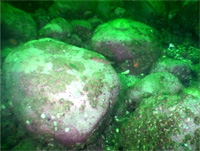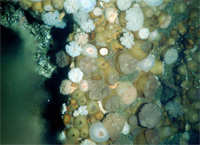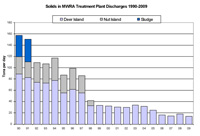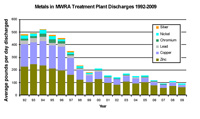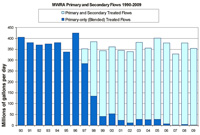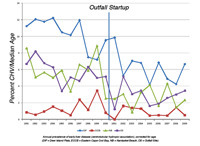FOR IMMEDIATE RELEASE
Ria Convery, Communications Director
(617) 788-1105, <ria.convery@mwra.state.ma.us>
MWRA'S SEWER TREATMENT PLANT AND OUTFALL
CONTINUE TO BENEFIT WATER QUALITY, ECOSYSTEMS
2009 Monitoring Data Released
|
MWRA is pleased to report that test results for 2009 show that the Deer Island Treatment Plant continues to operate as designed, and that discharges through the MWRA Outfall had no unexpected effects on the waters or ecosystems of Massachusetts and Cape Cod Bays.
In addition, no impacts of the outfall on the Stellwagen Bank National Marine Sanctuary were detected. Summaries of effluent results and ambient monitoring results follow.
DEER ISLAND EFFLUENT RESULTS
MWRA is required to perform stringent and specific tests on the Deer Island Treatment Plant and its effluent (the wastewater that is discharged through the MWRA outfall). Deer Island effluent continuously met water quality standards in 2009.
| Solids Reduced by Over 90% Since1990 | |||
| The amount of solids in MWRA effluent reached a record low in 2009. Overall, solids discharge levels have been reduced by over 90% since 1990. This means that the Deer Island Treatment Plant has been working effectively to remove particulate matter from the wastewater stream. | |||
|
|||
| Metals in effluent remained at low levels in 2009. Metals entering the plant have been reduced by industrial pre-treatment, and are further removed during secondary treatment so that the effluent meets stringent limits that protect marine life. | |||
|
|||
| (Primary secondary flow graph) Deer Island effluent continuously met secondary treatment limits. This indicates that the treatment plant has effectively reduced levels of Total Suspended Solids (TSS) and Carbon Oxygen Demand (cBOD) in wastewater before discharge. | |||
Pesticide in Boston Harbor and Massachusetts Bay Flounder Declining |
|||
| Levels of the banned pesticide chlordane in flounder fillets have been decreasing throughout the region compared to the 1990s. | |||
EFFECTS ON THE OCEAN AND ITS INHABITANTS
Researchers test Massachusetts Bay water, sediment and plant/animal communities to ensure that the MWRA outfall's treated effluent does not adversely impact the ocean or its inhabitants. No adverse impacts to the environment of the bays were detected in 2009.
| Rate of Liver Disease in Flounder Has Declined Since 1991 | |||
| In 2009, the rate of early liver disease in flounder remained low compared to 1991-2000, before the new treatment plant came on-line. | |||
| An Abundance of Whales in the Bays | |||
| Healthy whales continue to live in Massachusetts and Cape Cod Bays. In 2009 the number and diversity of the zooplankton that whales eat remained normal and typical for the area. | |||
###
Posted December 2, 2010
